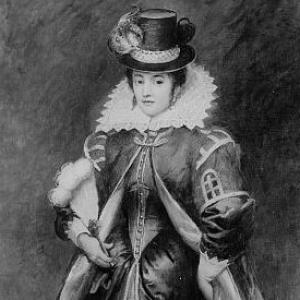Pocahontas

Among the most famous women in early American history, Pocahontas is credited with having helped the struggling English settlers in Virginia survive in the early 1600s. The explorer John Smith—who claimed Pocahontas saved his life—hailed her as “the instrument to pursurve this colonie from death, famine, and utter confusion.”
Born around 1596, Pocahontas was the daughter of Wahunsenaca (also known as Powhatan), the powerful chief of the Powhatans, a Native American group that inhabited the Chesapeake Bay region. Little is known about her mother. Her given name was Amonute (privately, Matoaka), but she has been remembered by her nickname Pocahontas, meaning “playful one.”
Pocahontas first observed the English when they landed in Jamestown, Virginia in May of 1607. She secured her place in American history when Captain John Smith was captured by Powhatan’s brother Opechancanough that winter. In published accounts, Smith claimed that as he was about to be executed, Pocahontas raced in and lay her head next to his, where it was about to be smashed on some rocks. Historians have debated Smith’s claims and many believe it was simply a tribal ritual, possibly one of adoption since Powhatan thereafter referred to Smith as a member of the tribe.
Nonetheless, Pocahontas developed a friendship with him and other settlers. She delivered messages from her father and accompanied Indian men delivering gifts of food to the starving colonists. However, the peace ended when colonists demanded more food, and Powhatan—facing shortages and drought in 1608 and 1609—declined. Colonists burned Indian villages and threatened violence, and from then on, Pocahontas ceased visiting Jamestown.
In 1610, Pocahontas married Kocoum, likely a member of the Patawomecks, and they settled in the Potomac region. In 1613, however, she was taken captive when Captain Samuel Argall invited her to visit his ship Treasurer. She was then transported to Jamestown. As ransom, English settlers demanded corn, the return of prisoners and stolen items, and a peace treaty. Some demands were met immediately; others Powhatan agreed to negotiate. Pocahontas was moved from Jamestown to the Henrico settlement near present-day Richmond and, in July 1613, met John Rolfe.
After a year of captivity, Sir Thomas Dale took Pocahontas and 150 armed men to Powhatan, demanding the remainder of the ransom. A skirmish occurred, and Englishmen burned villages and killed Indian men. During this event, Pocahontas told her father that she wished to marry Rolfe. Powhatan consented and the April 5, 1614 marriage was viewed by all as a peace-making event—the “Peace of Pocahontas.” In 1614, Pocahontas converted to Christianity and was renamed Rebecca. Rolfe helped save the Virginia colony by promoting tobacco cultivation, and was likely aided in some part by his wife.
Pocahontas bore a son named Thomas and, in 1616, the Rolfes traveled to England, spending time in London and Norfolk, where the extended Rolfe family lived. While there, Pocahontas dressed in the Elizabethan style pictured in her famous portrait. Considered an Indian princess by the English, she was granted an audience with King James I and the royal family. Shortly after the Rolfes set sail for their return to Virginia in 1617, Pocahontas became gravely ill from tuberculosis or pneumonia. She died shortly thereafter at the age of 22 and was buried in a churchyard in Gravesend, England.
- Barbour, Philip L. “Pocahontas” in James, Edward T., Janet Wilson James, Paul S. Boyer. Notable American Women: 1607-1950, A Biographical Dictionary. Cambridge: Belknap Press, 1971.
- Brown, Boyd H. “Pocahontas: Her Life and Legend.” National Parks Service. Accessed February 1, 2015.
- Hines, Emilee. More than Petticoats: Remarkable Virginia Women. Guilford, CT: The Globe Pequot Press, 2003.
- "Pocahontas." UXL Encyclopedia of U.S. History. Sonia Benson, Daniel E. Brannen, Jr., and Rebecca Valentine. Vol. 6. Detroit: UXL, 2009. 1241-1242. U.S. History in Context. Accessed February 1, 2015.
- "Pocahontas (1596?-1617)." American Eras. Vol. 2: The Colonial Era, 1600-1754. Detroit: Gale, 1997. 329. U.S. History in Context. Accessed February 1, 2015.
- Weatherford, Doris. American Women’s History: An A to Z of People, Organizations, Issues, and Events. New York: Macmillan General Reference, 1994.
- PHOTO: Library of Congress
MLA - Michals, Debra. "Pocahontas." National Women's History Museum. National Women's History Museum, 2015. Date accessed.
Chicago - Michals, Debra. "Pocahontas." National Women's History Museum. 2015. www.womenshistory.org/education-resources/biographies/pocahontas.
Web Sites:
Books:
-
Price, David A. Love and Hate in Jamestown: John Smith, Pocahontas and the Heart of a New Nation. New York: Knopf, 2003.
-
Cusstalow, Dr. Linwood “Little Bear” and Angela L. Daniel “Silver Star.” The True Story of Pocahontas: The Other side of History. Golden: Fulcrum Publishing, 2007.
-
Roundree, Helen C. Pocahontas, Powhatan, Opechancanough: Three Indian Lives Changed by Jamestown. Charlottesville: University of Virginia Press, 2005.
-
Townsend, Camilla. Pocahontas and the Powhatan Dilemma: The American Portrait Series. New York: Hill and Wang, 2004.




